The Friday Photo: Nine Dragon Pond
It’s been sunny lately. So t’other day we went to the park.
And the park was a lake. With nine dragons.
Now, the Chinese have been landscaping dazzling gardens for over three millennia now, so beauty shouldn’t come as a surprise.
But…
It did.
Right now Chinese society is urbanizing as fast as the US did during its own Gilded Age, more than a century ago.
Rural Chinese are moving into the cities, or the cities are sprawling out to them, at the rate of approximately twenty million people each year. And folk live stacked on top of one another at a density that’s hard to comprehend.
I wrote about the buses. But we’ve waited ten or twenty minutes for a LIFT that we can compress ourselves into before (or, for that matter, after) the “overload” sign starts flashing.
And this is lil’old Kunming. Not Beijing, Shanghai, let alone Guangzhou, a city more populous than Poland.
With all these people, gardens and parks, however tiny, become a precious refuge. Every evening, the tiny concrete and bamboo garden at the base of our flats fills with grandparents doing calisthenics and mothers counting fish with their nappy-less babies.
The pool is placed, of course, with all due reference to the principles of feng shui. A system in which, like lucky and unlucky numbers and colours, the overwhelming majority of even the most educated Chinese place great faith.
Even high panjandrums at international companies have to go through a feng shui rigmarole to reassure their staff…
Cuihu Park is in the centre of Kunming, more water than wind. We’ve passed it but never stopped. It meanders over and within a lake once known as “Nine Dragon Pond” for the nine springs that feed it, as a series of paved embankments and concreted islets lovingly shielded with trees.
On our way we pass a little gateway that opens off bustling, high-rise, neon-clad Renmin Zhong Lu into, well, a surprisingly timeless space.
It’s tiny. A tree-lined path leads to a little bridge over water and a pavilion.
It looks quiet. But it bubbles with people.
Beside the path are rows of tables, at which the elderly sit for hours, gambling and kibitzing games of Chinese chequers (guys) and mahjong (girls). A little café churns out weak green tea for a cent or so per cup.
We stop a while. Kibitz. Make our (limited) conversation with interested parties.
And then we wander up to Cuihu Park, and take a walk along one of the paved roads that lead across the water.
It’s so green! Fields of water lilies, weeping willow trees, tailored conifers, stands of bamboo, red-tiled pavilions. And from almost every viewpoint it’s made to feel as though you’re alone with nature.
You’re not, of course.
Even compared to the parks in Hanoi, we are gobsmacked by how many people there are, doing so many different things, in this tiny space.
One walkway is lined with musicians, playing the instruments whose names we don’t yet know, generating the nasal, sawing, gonging pentatonic tones that mimic the sounds of the alien language we are learning.
A man plays a trumpet-like instrument on a park bench, solo. Two bandstands, almost side by side, boast their own house band, each with their own enthusiastic audience.
Then, bizarrely, three competing duos of traditional dancers, all from the same one of Yunnan province’s 26 ethnic groups, within a space of a hundred yards.
They’re here for the tourists, yet, bar a couple of backpackers and us, their seated audience is largely elderly, low-income and Chinese.
There’s a wooden shed selling cheap plastic toys and snacks of pickles, sesame, peanuts, sausage, jellies, a children’s fairground, rolling inflatables on which to jog, hamster-style, on the water.
In an open area on the central island, maybe 30 or 40 metres square, we count four separate classes.
There’s a Chinese dance class, with a handsome, black-clad teacher and some of his older female students dressed to kill. A disco dance class. Something that looks like Country & Western, except the music’s Chinese, so it can’t be…
Or can it?
And calisthenics, or tai chi, the staple of Communist Asia.
Both classes and audience move round each other effortlessly, intuitively. They are used to life in small spaces, the kidney-compressing squish of the public buses, creating space for others to do their thing.
We gawp quite a bit at the views of willows and high rises. Cuihu is not a beautiful park by Chinese standards. But for Z it’s beautiful. And for me, it recalls the koi carp pavilions in the Japanese gardens I walked with my grandparents in southern England as a child.
We head towards the big pavilion on the central island, drawn by the crowd. What are they watching?
A singing class. Maybe a hundred people, all gathering in the sun to sing.
The songs sound uplifting, parade songs, not marching songs, not folk songs. A tribute to great mother China, perhaps? We don’t have the Chinese to hear them…
But it’s strangely moving to see so many people gathered here in a public place to sing.
There are no school-age children. I’ll write about Chinese education later, but let’s just say for now that kids in an emerging hyperpower with a Confucian tradition don’t get the downtime we unschoolers provide.
This city centre park gives us a sense of scale. A sense of multitudes of people.
But on our first weekend here, we went up to Haigeng Park. It’s in the suburbs, on the borders of a sports-boat lake that also serves for hydroelectric power (in central Laos, we saw the Chinese need for hydroelectricity writ large).
We came for the minigolf. And HaiGeng has two 18-hole championship minigolf courses, splendiferous affairs with waterfalls, Zen gardens and fake grottoes to play through.
What struck us about it, though? The scale.
Yunnan is a small province, as Chinese provinces go — only 4% of the nation’s landmass. It’s around 400,000 square kilometres — a bit smaller than California, a bit bigger than Germany, a bit less than double the size of the UK.
There are sixteen (count’em) football fields. Towering blocks of athlete accommodation. Multiple gymnasiums. A vast boating lake, whose architecture rings Z’s bells. An entire network of internal roads.
Swathes of human-powered, durable exercise machines, on which we swing and jump. Tracks. Pools. Tennis courts. Basketball courts.
And, no, it’s not the only place this size in town.
I fell in love with Indonesia.
And now I’m a little bit in love with China. Don’t hate me, Indonesia.

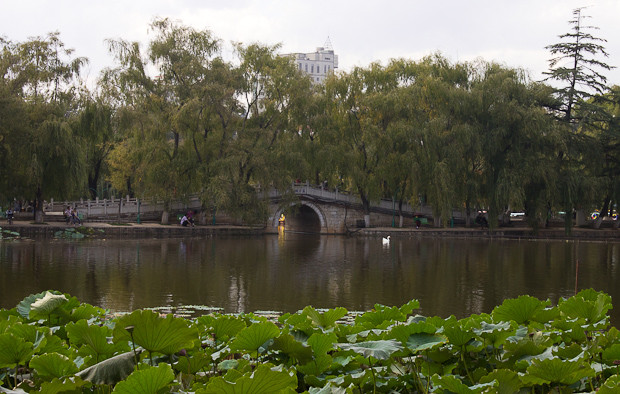
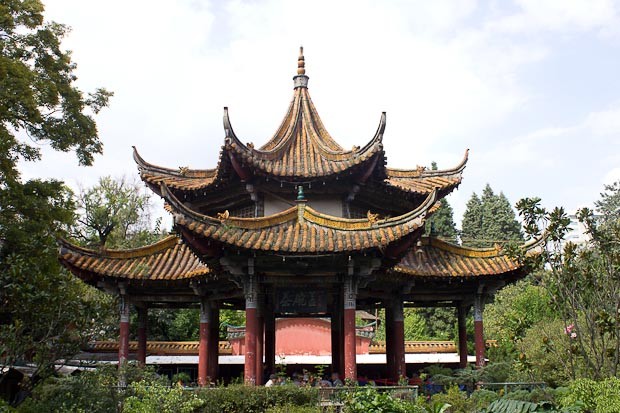
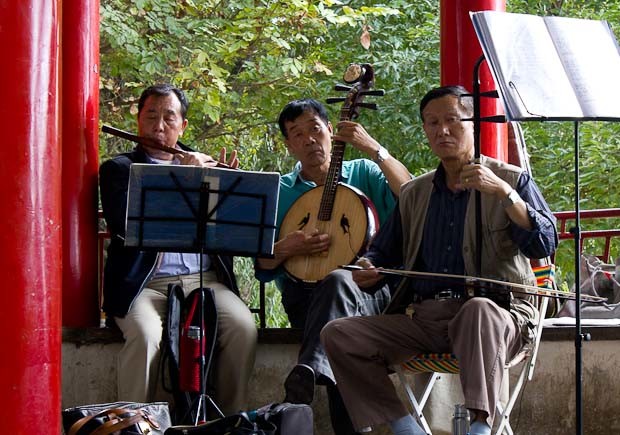
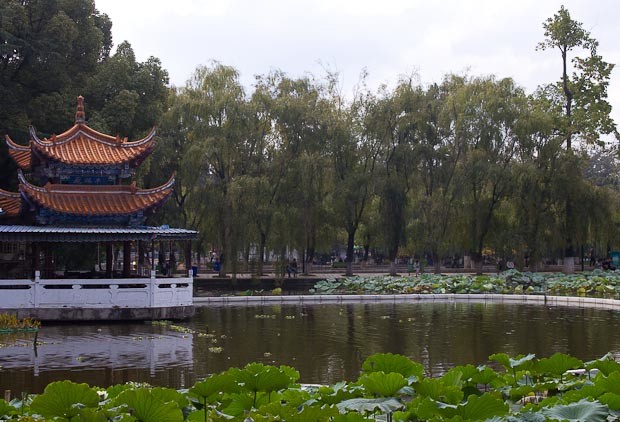
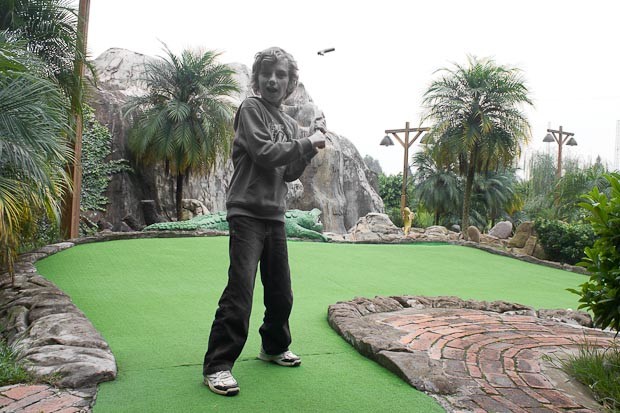
what amazing photos – a gorgeous place!! i know i have zombies on the brain, but that photo of z?? he sort of looks zombified. lol!
Ha! He styled the photo himself in Adobe Lightroom. I think it’s kind of cool, but then I am, obviously, his mother…
Is Cuihu Park the same as “Green Park”? Looks the same with willow trees and water lilies but prob not.
Yes. I think Cuihu translates as Green Lake park. It’s the one between the university/Wenlin Jie (the foreigner street with all the restaurants and bars) and “downtown” — little bit West of the centre but inside the inner ring road.